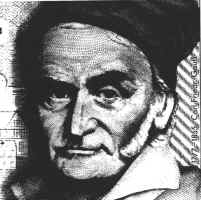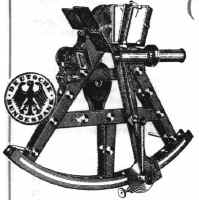 Article taken from "Backsights"
Magazine published by Surveyors Historical Society
Article taken from "Backsights"
Magazine published by Surveyors Historical Society |
CARL
FRIEDRICH GAUSS
by Fred Roeder, P.S.,
1993
Every self-respecting
surveyor knows that our first, third and sixteenth Presidents had - for a brief
period in their lives - been surveyors. But not even the most chauvinistic
of our peers would argue that Washington's picture appears on a one dollar bill
because of our country's desire to honor a great surveyor. Surveyors just
are not that famous...or are they?
 Imagine my surprise when
my nephew handed me a new German ten mark bill, and my eyes fell on a
triangulation diagram consisting of a chain of triangles connecting 17 named
stations, alongside a picture of a sextant covering almost half the bill.
On the obverse was a portrait of Carl Friedrich Gauss and the equation of his
famous error curve. Imagine my surprise when
my nephew handed me a new German ten mark bill, and my eyes fell on a
triangulation diagram consisting of a chain of triangles connecting 17 named
stations, alongside a picture of a sextant covering almost half the bill.
On the obverse was a portrait of Carl Friedrich Gauss and the equation of his
famous error curve.
I doubt seriously that the
average German knows more about Gauss than does the average American, who is in
the top 10% if he knows that Gauss was one of the three greatest mathematicians
of all time (the others being Archimedes and Newton), whose accomplishments fill
pages in any encyclopedia of mathematics and science. It is therefore all
the more remarkable that those in charge of designing money chose to honor Gauss
the geodetic surveyor, rather than Gauss the mathematician and astronomer.
It helps to drive home an important truth: the surveyor plays a key role
in the life of any civilized society.
Carl Friedrich Gauss was
born in 1777 into a poor family (his father was a gardener) in the German city
of Braunschweig (Brunswick). He was an extremely precocious child,
astounding his parents and teachers with his mathematical abilities from the age
of three years. There is a story that the child mentally added the numbers
from one to one hundred in a few minutes by reasoning that the order in which
they are added doesn't matter, and he simply added 1+99+2+98+3+97...all the way
to 49+51, reducing the whole problem to (49x100)+100+50 = 5,050. While
still a teenager, he propounded the theory of least squares, demonstrated a
solution to the age-old problem of dividing a circle into 17 parts, and made
important mathematical discoveries which he was too shy to publish and entrusted
only to his diary.
His genius came to the
attention of Ferdinand, Duke of Brunswick, who undertook to finance his
education and, in the process, became his lifelong patron and friend.
Gauss attended the University of Gottingen and in 1799 got a Doctorate in
Mathematics from the University of Helmstedt. About this time he turned
his attention to astronomy, making brilliant computations of orbits of
asteroids. In 1807, he became director of the observatory in Gottingen, a
post he held until his death in 1855.
Most of his contributions
to mathematics and science he set down in about 155 meticulously written
papers. He published anything only after the most thorough investigation
and after he was sure it met his motto: "Ut nihil amplius
desiderandum relictum sit" - that nothing further remains to be done.
His mind was so full of numbers that when he was interrupted in solving a
problem, and told that his wife was dying, he reportedly replied:
"Tell her to wait until I am done."
From about 1817 Gauss made
studies in geodesy. His interest was aroused by a need for an accurate
determination of the geographical position of his observatory. In 1828 he
was commissioned by George IV of England to triangulate the entire Kingdom of
Hannover. Hannover is a hilly expanse of about 15,000 square miles in
northern Germany between the Elbe River and the Dutch border, which in those
days belonged to England, the English monarchs being of the house of Hannover.
 The
heliotrope appears in a biography of Ferdinand Rudolph Hassler, who helped
establish the U. S. Coast Survey, titled The Chequered Career of Ferdinand
Rudolph Hassler, written by Florian Cajori. The
heliotrope appears in a biography of Ferdinand Rudolph Hassler, who helped
establish the U. S. Coast Survey, titled The Chequered Career of Ferdinand
Rudolph Hassler, written by Florian Cajori.
Heliotropes are
mentioned as having been invented by K. F. Gauss of Gottingen,
Germany. In a report to the Secretary of the Treasury, dated
November 17, 1837, Hassler wrote:
"Heliotropes, of
which I had begun the use of last fall, have this year been used for most
of the station points, and for the base points exclusively. I caused
one to be constructed in our shop last winter, after the two received from
Gottingen, by the kind assistance of Professor Gauss, the inventor of this
instrument; and during my work this summer, I received four more; all
seven are now in activity. The aim of the instrument is: to
reflect the sun's image from the station-point, at which they are placed,
to the observer at his station. The new instruments require a man of
some intelligence to attend them, and to replace them about every four
minutes, according to the motion of the sun...They will show a precise
luminous point, even though haze, so frequent on the eastern seashore,
when the outline of the hill itself, upon which they stand, cannot be
traced."
--from "The
Heliotrope: The Shy Flower of Surveying", by Harold Nelson. |
Gauss was too much of a
mathematician to fall in love with the mechanics of triangulation.
"All the measurements in the world are not worth one theorem by which the
science of eternal truth is genuinely advanced," he once wrote. The
survey, which Gauss completed in 1847, did not produce a very accurate map of
Hannover, there being more to making a map than establishing geodetic position
on a few triangulation stations. It resulted, however, in a number of
important advances in the mathematics of curved surfaces, such as his
development of curvilinear coordinates. To increase the accuracy of his
observations he developed a new lens (Gauss eyepiece, still used for
auto-collimation in spectrometers). To improve pointing accuracy on
distant targets he invented the heliotrope. The most important result of
his triangulation was a book on geodesy, which he published in two volumes
between 1844 and 1847.
Gauss probably did not
consider himself a surveyor any more than George Washington did.
But--'Tell me what you do and I will tell you what you are.' I think our
profession can claim him for his immense contributions to surveying and accept
the honors on the German 10 mark bill.
--New
Mexico Professional Surveyors Newsletter. July 1992
--The
Cornerpost: Journal of the Vermont Society of Land Surveyors. September
1992
|
